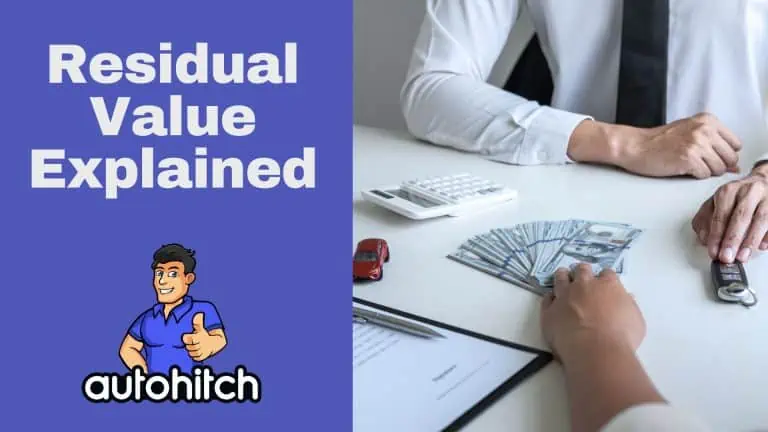If you’re considering leasing a car, one term you’ve probably already come across is “residual value.”
In this article, I’ll break down the concept of residual value, explain how it’s calculated, and provide tips on how to navigate it when leasing a car.
What is the Residual Value of a car?
The residual value (Also known as Resale Value) is the estimated value of the leased vehicle at the end of the lease term, typically 2-4 years. It represents how much the car is expected to be worth after depreciation over the lease period.
The residual value is set by the leasing company or financial institution providing the lease and is calculated as a percentage of the vehicle’s manufacturer’s suggested retail price (MSRP).
For example, if a car has an MSRP of $30,000 and the residual value is set at 50%, the residual value would be $15,000.
| MSRP | Residual Value Percentage | Residual Value |
|---|---|---|
| $30,000 | 50% | $15,000 |
Table of Contents
Relevant Articles To Read:
- What Happens at the End of a Car Lease
- How To Get Out Of A Car Lease
- How to Lease a Tesla
- How To Lease A Car Through Your Business
- How Old Do You Have to Be to Lease a Car
How is Residual Value Determined?
To calculate the residual value of your car, use the formula below:
| Step | Description |
|---|---|
| 1 | Obtain the MSRP (Manufacturer’s Suggested Retail Price) of the vehicle |
| 2 | Find the residual value percentage for that vehicle and lease term (typically provided by the leasing company) |
| 3 | Calculate the residual value by multiplying the MSRP by the residual value percentage: Residual Value = MSRP x Residual Value Percentage |
For Example: For example, if the MSRP is $30,000 and the residual percentage is 55% for a 36-month lease:Residual Value = $30,000 x 0.55 = $16,500So the estimated residual value, which is the vehicle’s projected worth at the end of the 36-month lease, is $16,500.
TIP: Leasing companies don’t just crunch these numbers as you negotiate; they use sophisticated data and analysis to estimate the future value and then set residual values for each car.
Some key factors they consider in their calculation include:
- Vehicle reliability and quality ratings
- Brand reputation and demand
- Vehicle segment and competition
- Projected annual mileage
- Current and projected fuel costs
- Economic conditions
The goal is to accurately predict how much the vehicle will depreciate over the lease term based on historical data for that model and market conditions.
The Best Residual Value Calculators
After doing some searching and reading reviews, the top 3 residual value calculators I found are listed below:
Based on the search results provided, here are the top 3 online residual value calculators:
1. iCalculator Residual Value Calculator
This calculator from iCalculator allows you to calculate the residual value of an asset based on its cost, scrap/sale rate, and expected lifespan. It provides a detailed explanation of the residual value formula and how to use the calculator.
2. Calculator.Academy Residual Value Calculator
This simple calculator from Calculator.Academy lets you enter the original cost, annual depreciation rate, and age of the asset to determine its residual value. It also provides the residual value formula and an example calculation.
3. GoodCalculators Residual Value Calculators
GoodCalculators offers two residual value calculators – one for straight-line depreciation and one for declining balance depreciation.
These calculators display the depreciation schedule over 5 years and provide the formulas used in the calculations.
While a few other sites like Edmunds and Leasehackr have auto lease calculators that factor in residual values, the three calculators above are dedicated specifically to calculating residual value for any type of asset based on cost, depreciation rate, and lifespan parameters.
What Is Considered a Good Residual Value?
Based on my assessment of the current market, a good residual value percentage for a leased car is generally considered to be in the range of 55-65% of the vehicle’s MSRP (Manufacturer’s Suggested Retail Price).
Example of a Car Lease – Residual Value Explained
Let’s create an example of a car lease deal based on a vehicle with an MSRP of $35,000. We’ll compare two different residual value percentages to demonstrate how residual value affects the monthly lease payment.
Lease Deal Example:
- MSRP: $35,000
- Lease Term: 36 months
- Annual Mileage Allowance: 12,000 miles
| Residual Value Percentage | Residual Value | Depreciation Cost | Monthly Depreciation Cost | Monthly Lease Payment (with $500 fees)* |
|---|---|---|---|---|
| 55% | $19,250 | $15,750 | $437.50 | $937.50 |
| 45% | $15,750 | $19,250 | $534.72 | $1,034.72 |
*Monthly Lease Payment is calculated by adding the Monthly Depreciation Cost and dividing the total lease fees ($500 in this example) by the lease term (36 months).
In this example, the car with a 55% residual value has a lower monthly depreciation cost of $437.50, resulting in a monthly lease payment of $937.50 (assuming $500 in total lease fees).
On the other hand, the car with a 45% residual value has a higher monthly depreciation cost of $534.72, leading to a higher monthly lease payment of $1,034.72.
This example demonstrates how a higher residual value percentage results in a lower monthly lease payment, while a lower residual value percentage leads to a higher monthly lease payment.
It’s important to note that the actual lease payments may vary depending on factors such as negotiated selling price, lease fees, taxes, and interest rates.
Why Residual Value Matters
Residual value is important because it directly impacts your monthly lease payment.
You are essentially paying for the portion of the vehicle’s value that you “use up” through depreciation during the lease term.
A higher residual value means less depreciation cost for you to pay, resulting in lower monthly payments. Conversely, a lower residual value means higher depreciation and higher monthly costs.
Consider this example of leasing a $30,000 vehicle for 3 years:
| Residual Value Percentage | Residual Value | Depreciation Cost | Monthly Payment (Depreciation / 36 months) |
|---|---|---|---|
| 50% | $15,000 | $15,000 | $416.67 |
| 40% | $12,000 | $18,000 | $500.00 |
Can Residual Value Be Negotiated?
Yes, it is possible to negotiate the residual or resale value at the dealership, but it can be tricky. Here’s a simple explanation of the best approach. To negotiate a better residual value:
- Research the cars residual value for your specific make/model from third-party lease guides like Edmunds or LeaseGuide.com before going to the dealer. This gives you a baseline to negotiate from.
- Ask the dealer to show you the value they are quoting for your lease. If it’s lower than third party guides, negotiate for a higher number closer to market rates.
- Get quotes from multiple dealers. The more options you have, the more leverage you’ll have to get the best deal.
- Time your negotiation right before the end of the month/quarter when dealers are trying to hit sales goals. They may be more flexible then.
- Be prepared to walk away if they won’t budge on an unreasonable residual rate. Above all else, don’t get trapped into bad lease terms.
Lease-End Options and Residual Value
At the end of a lease, you typically have the option to either return the vehicle to the dealer or buy it outright for the residual value plus any fees and taxes.
What If My Car is Worth More Than the Residual Value
If a car you leased is now worth more than the residual value stated in your lease agreement, it means you have positive equity in the car. You could take advantage of this one of three way:
1. Buy out the lease
One option is to purchase the car by paying the residual value stated in your lease contract. Since the car’s market value exceeds the residual value, you are essentially buying the car for less than its current worth. This allows you to capture the equity.
For example, if the residual value in your contract is $15,000 but the car is actually worth $18,000, you can buy it for $15,000 and immediately have $3,000 in equity. You can then choose to keep the car long-term or sell it to pocket that equity amount.
2. Trade it in
Another option is to trade in the leased car towards the purchase of a new vehicle. The dealer will pay you the higher market value rather than just the residual value stated in your lease contract. This positive equity can then be applied towards the purchase or lease of your next car as a down payment or capitalized cost reduction.
For instance, if the residual value is $15,000 but the trade-in value is $18,000, you have $3,000 in positive equity that can offset the costs of your next vehicle transaction.
3. Sell it to a third party
Some leasing companies allow you to purchase the car yourself at the residual value and then sell it to a third party for the higher market value, pocketing the difference as profit.
However, not all leasing companies permit this, so you would need to check your contract terms.
Conclusion
While you may not always be able to negotiate the residual value directly, shopping around and comparing lease deals can help you find a more favorable residual percentage.
Additionally, keep an eye on the market value of your leased vehicle throughout the lease term to help you decide whether to buy out the lease or return the car.
One final piece of advice:
Consider the total cost of the lease, not just the monthly payment. Factor in the down payment, fees, and potential mileage overage charges to get a complete picture of your expenses.



